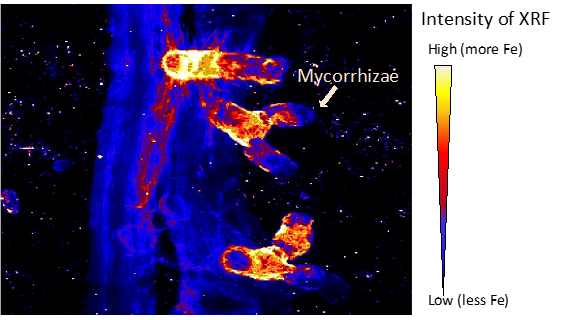Environmental Transformations and Interactions
Ectomycorrhizal Fungi Enhance Pine Growth by Promoting Iron Uptake
Research demonstrates how ectomycorrhizal fungi help pine plants process iron.

Through a recent study, scientists studied how ectomycorrhizal fungi help pine plants process iron. (Image by Clark Ahlstrom | iStock)
The Science
Ectomycorrhizal fungi (EMF) play a pivotal role in forest ecology. They serve as a primary fungal group that establishes biochemical symbiotic exchanges with trees, trading photosynthetically fixed carbon for soil nutrients. Iron, an essential plant nutrient, is crucial for metabolic functions of living organisms. The specific mechanisms by which pine plants process iron within EMF associations, however, remain poorly understood. Mesocosm experiments (large, controlled outdoor experimental environments), where pine seedlings were inoculated with various EMF species under iron-enriched and iron-depleted conditions, followed by lab-based analyses, has shed light on this interaction. The findings revealed that while EMF environments enriched with iron improved pine seedling growth, this benefit negatively affects formation of mycorrhizae and the uptake of plant macronutrients.

The Impact
Iron is an essential micronutrient for living organisms because it is vital for numerous metabolic processes. However, plants may find it challenging to access iron in well-aerated soils because it readily oxidizes and forms insoluble iron oxides. Understanding the role of different ectomycorrhizal fungi (EMF) species in plant iron uptake is critical for grasping how EMF-plant interaction influences iron cycling in forest ecosystems. A multi-institutional team of researchers discovered that inoculating plants with multiple EMF species significantly enhanced iron acquisition from the soil to the roots and initiated a range of iron-dependent physiological and biochemical processes in the mycorrhizal roots, markedly benefiting plant growth. The findings highlight the potential significance of EMF diversity in promoting forest ecosystem health and strengthening the symbiotic relationship between mycorrhizae and host plants.
Summary
A multi-institutional team of scientists investigated the interplay between the addition of iron and plant-mycorrhizal interactions, especially the molecular mechanisms underlying mycorrhiza-assisted iron processing in plants. Using synchrotron X-ray fluorescence imaging at Brookhaven National Laboratory, meta-transcriptomics at the Joint Genome Institute (JGI), and nuclear magnetic resonance spectroscopy at the Environmental Molecular Sciences Laboratory (EMSL), the latter two of which are Department of Energy (DOE) Office of Science user facilities, researchers found that iron addition significantly diminished the mycorrhiza formation rate and reduced symbiosis-related metabolite concentrations in pine seedling roots. This occurred, however, while significantly promoting pine growth. The results indicate a trade-off between iron-mediated plant growth and symbiotic performance. However, the extent of this trade-off appears to depend on the interactions between the host plant and the EMF community. Specifically, dual EMF species inoculation exhibited a superior capacity for iron acquisition from soil to the roots compared to single EMF species treatments These EMF species catalyzed a broad array of iron-related functions, triggering various iron-dependent physiological and biochemical processes in mycorrhizal roots that significantly contributed to plant growth. These processes, however, may demand a larger carbon cost in mycorrhizal roots.
Contacts
Kaile Zhang, University of Florida, kaile.zhang@ufl.edu
Haihua Wang, University of Florida, wanghaihua@ufl.edu
William Kew, EMSL, william.kew@pnnl.gov
Hui-Ling (Sunny) Liao, University of Florida, sunny.liao@ufl.edu
Funding
A portion of this research was performed on a project award under the Facilities Integrating Collaborations for User Science program through EMSL at Pacific Northwest National Laboratory and the Joint Genome Institute at Lawrence Berkeley National Laboratory, which are both DOE Office of Science user facilities.
Publication
K. Zhang, et al. “Ectomycorrhizal fungi enhance pine growth by stimulating iron-dependent mechanisms with trade-offs in symbiotic performance.” New Phytologist (2023). [DOI: 10.1111/nph.19449]

